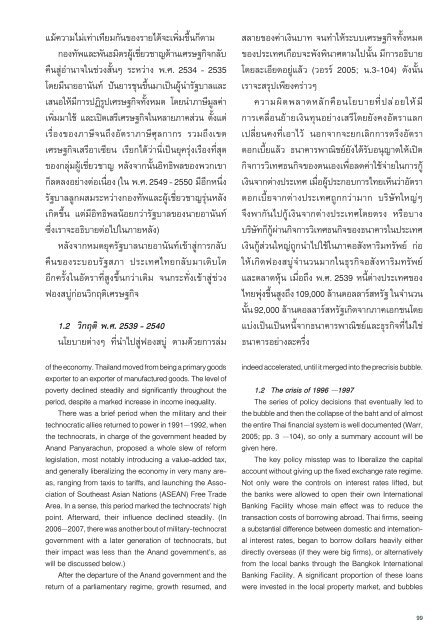บ้านเรือนถิ่นไทยในช่วงเจ็ดทศวรรษ 2489-2559
You also want an ePaper? Increase the reach of your titles
YUMPU automatically turns print PDFs into web optimized ePapers that Google loves.
แม้ความไม่เท่าเทียมกันของรายได้จะเพิ่มขึ้นก็ตาม<br />
กองทัพและพันธมิตรผู้เชี่ยวชาญด้านเศรษฐกิจกลับ<br />
คืนสู่อำนาจในช่วงสั้นๆ ระหว่าง พ.ศ. 2534 - 2535<br />
โดยมีนายอานันท์ ปันยารชุนขึ้นมาเป็นผู้นำรัฐบาลและ<br />
เสนอให้มีการปฏิรูปเศรษฐกิจทั้งหมด โดยนำภาษีมูลค่า<br />
เพิ่มมาใช้ และเปิดเสรีเศรษฐกิจในหลายภาคส่วน ตั้งแต่<br />
เรื่องของภาษีจนถึงอัตราภาษีศุลกากร รวมถึงเขต<br />
เศรษฐกิจเสรีอาเซียน เรียกได้ว่านี่เป็นยุครุ่งเรืองที่สุด<br />
ของกลุ่มผู้เชี่ยวชาญ หลังจากนั้นอิทธิพลของพวกเขา<br />
ก็ลดลงอย่างต่อเนื่อง (ใน พ.ศ. 2549 - 2550 มีอีกหนึ่ง<br />
รัฐบาลลูกผสมระหว่างกองทัพและผู้เชี่ยวชาญรุ่นหลัง<br />
เกิดขึ้น แต่มีอิทธิพลน้อยกว่ารัฐบาลของนายอานันท์<br />
ซึ่งเราจะอธิบายต่อไปในภายหลัง)<br />
หลังจากหมดยุครัฐบาลนายอานันท์เข้าสู่การกลับ<br />
คืนของระบอบรัฐสภา ประเทศไทยกลับมาเติบโต<br />
อีกครั้งในอัตราที่สูงขึ้นกว่าเดิม จนกระทั่งเข้าสู่ช่วง<br />
ฟองสบู่ก่อนวิกฤติเศรษฐกิจ<br />
1.2 วิกฤติ พ.ศ. 2539 - 2540<br />
นโยบายต่างๆ ที่นำไปสู่ฟองสบู่ ตามด้วยการล่ม<br />
of the economy. Thailand moved from being a primary goods<br />
exporter to an exporter of manufactured goods. The level of<br />
poverty declined steadily and significantly throughout the<br />
period, despite a marked increase in income inequality.<br />
There was a brief period when the military and their<br />
technocratic allies returned to power in 1991–1992, when<br />
the technocrats, in charge of the government headed by<br />
Anand Panyarachun, proposed a whole slew of reform<br />
legislation, most notably introducing a value-added tax,<br />
and generally liberalizing the economy in very many areas,<br />
ranging from taxis to tariffs, and launching the Association<br />
of Southeast Asian Nations (ASEAN) Free Trade<br />
Area. In a sense, this period marked the technocrats’ high<br />
point. Afterward, their influence declined steadily. (In<br />
2006–2007, there was another bout of military-technocrat<br />
government with a later generation of technocrats, but<br />
their impact was less than the Anand government’s, as<br />
will be discussed below.)<br />
After the departure of the Anand government and the<br />
return of a parliamentary regime, growth resumed, and<br />
สลายของค่าเงินบาท จนทำให้ระบบเศรษฐกิจทั้งหมด<br />
ของประเทศเกือบจะพังพินาศตามไปนั้น มีการอธิบาย<br />
โดยละเอียดอยู่แล้ว (วอรร์ 2005; น.3-104) ดังนั้น<br />
เราจะสรุปเพียงคร่าวๆ<br />
ความผิดพลาดหลักคือนโยบายที่ปล่อยให้มี<br />
การเคลื่อนย้ายเงินทุนอย่างเสรีโดยยังคงอัตราแลก<br />
เปลี่ยนคงที่เอาไว้ นอกจากจะยกเลิกการตรึงอัตรา<br />
ดอกเบี้ยแล้ว ธนาคารพาณิชย์ยังได้รับอนุญาตให้เปิด<br />
กิจการวิเทศธนกิจของตนเองเพื่อลดค่าใช้จ่ายในการกู้<br />
เงินจากต่างประเทศ เมื่อผู้ประกอบการไทยเห็นว่าอัตรา<br />
ดอกเบี้ยจากต่างประเทศถูกกว่ามาก บริษัทใหญ่ๆ<br />
จึงพากันไปกู้เงินจากต่างประเทศโดยตรง หรือบาง<br />
บริษัทก็กู้ผ่านกิจการวิเทศธนกิจของธนาคารในประเทศ<br />
เงินกู้ส่วนใหญ่ถูกนำไปใช้ในภาคอสังหาริมทรัพย์ ก่อ<br />
ให้เกิดฟองสบู่จำนวนมากในธุรกิจอสังหาริมทรัพย์<br />
และตลาดหุ้น เมื่อถึง พ.ศ. 2539 หนี้ต่างประเทศของ<br />
ไทยพุ่งขึ้นสูงถึง 109,000 ล้านดอลลาร์สหรัฐ ในจำนวน<br />
นั้น 92,000 ล้านดอลลาร์สหรัฐเกิดจากภาคเอกชนโดย<br />
แบ่งเป็นเป็นหนี้จากธนาคารพาณิชย์และธุรกิจที่ไม่ใช่<br />
ธนาคารอย่างละครึ่ง<br />
indeed accelerated, until it merged into the precrisis bubble.<br />
1.2 The crisis of 1996 –1997<br />
The series of policy decisions that eventually led to<br />
the bubble and then the collapse of the baht and of almost<br />
the entire Thai financial system is well documented (Warr,<br />
2005; pp. 3 –104), so only a summary account will be<br />
given here.<br />
The key policy misstep was to liberalize the capital<br />
account without giving up the fixed exchange rate regime.<br />
Not only were the controls on interest rates lifted, but<br />
the banks were allowed to open their own International<br />
Banking Facility whose main effect was to reduce the<br />
transaction costs of borrowing abroad. Thai firms, seeing<br />
a substantial difference between domestic and international<br />
interest rates, began to borrow dollars heavily either<br />
directly overseas (if they were big firms), or alternatively<br />
from the local banks through the Bangkok International<br />
Banking Facility. A significant proportion of these loans<br />
were invested in the local property market, and bubbles<br />
99


















